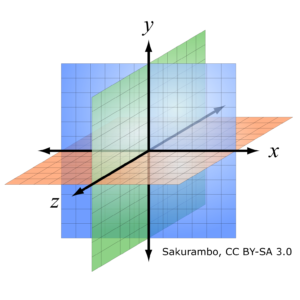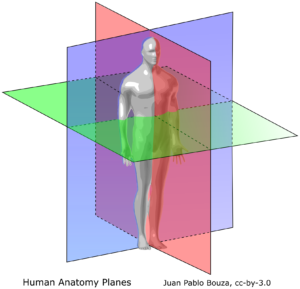What do Laban’s planes of movement have to do with belly dance? Let’s start with the general (Cartesian co-ordinates) and then make it more specific to the human body (anatomical planes). And then apply it to dance (Laban’s planes of movement). By applying these concepts to your belly dance practice, you can improve your movement isolation, a key feature of belly dance.
Cartesian Co-Ordinates
So, what are Cartesian co-ordinates?

Our three-dimensional world can be sliced into three flat, perpendicular planes. These intersect at a central origin point. Why does this matter? With this representation, we can describe the location of any object relative to the central origin point.
Human Anatomy Planes
Now what does this have to do with dance? Put the human body at the central origin point. Now you have the human anatomical planes. These are a way to describe the location of body structures and the direction of body movements. Getting warmer now …

Laban’s Planes of Movement
And finally, how did Rudolf Laban adapt these for dance and movement analysis? Laban was a dancer, choreographer, and theoretician. One of the many things he is remembered for today is ‘Laban movement analysis’, a way of describing and documenting human movement. The idea of the table, door, and wheel planes comes from his movement analysis method.

The table plane is the horizontal plane which separates up and down. I’ve heard movements in this plane described like you are stuck in the centre of a table. Your movements must be on this flat surface. The door plane is the vertical plane which separates front from back. You can imagine being stuck between two panes of glass in this plane. Your movements must stay within these panes. The wheel plane is the vertical plane which separates left from right. Like you are stuck in a wheel and can only move backwards and forwards within the wheel.
Application to Belly Dance
What does this have to do with belly dance? In my opinion, due to the isolated nature of belly dance movements, most movements fall into one plane or another. For example, taks, hip drops, and vertical figure 8s fall within the door plane. Twists, horizontal hip circles and horizontal figure 8s are in the table plane. Undulating movements like camels within the wheel plane. I find that understanding of the planes of movement and belly dance moves is helpful when practising isolation technique. For example, you can imagine yourself stuck between two panes of glass when doing a vertical figure 8. That helps reduce unnecessary twisting.
Next time you drill a belly dance move, why not imagine yourself stuck in a table, door, or wheel? Does that help your isolation?
